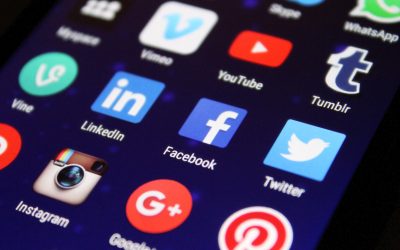Linkedin for B2B
Networking has never been easier (or even that fun). Nowadays, we can network almost everywhere (as long as an internet connection is available). As there are many social media platforms out there to choose from, in this article, we will focus on LinkedIn for b2b.
Chances are you have heard of LinkedIn before. If you are a business owner, you probably already have an account. Anyway, even if you have been operating there for a while, there’s always room to learn.
LinkedIn for b2b presents a tremendous business opportunity by:
- Posting content that inspires, and being inspired by others’.
- Building a community of like-minded professionals sharing interests and trends.
- Increasing creativity and motivation.
😏 In short, Linkedin for B2B allows you to find, and to be found…where the action happens. What’s not to like?
Whether you are already part of this SoMe platform or considering signing up, keep reading this blog post. We are on LinkedIn and enjoying the experience and benefits so far!
Networking in linkedin for b2b versus traditional networking
Back in the not so old days networking used to be quite different. New leads were generated in trade fairs, and contacts were added to your address book. Many deals were sealed at your client’s office, sometimes in a business lunch at a restaurant.
So far, so good. However, each interaction took lots of resources (time and money). That’s how things were done back then. However, as the world is changing, so are the new ways of operating.
The digital ecosystem we all live in now presents different opportunities and interactions. You don’t need to be cold-calling your potential customers anymore. It does feel awkward (to both sides, the caller and the receiver). There are new ways to generate leads and nurture them. (Think of email marketing, for instance).
Say goodbye to outdated methods such as email blast. Clients want to receive personalised messages. But, for sure, you still want and need to make connections.
😏 LinkedIn makes business interactions costless and easier. It is less awkward to introduce yourself by instant messaging than in real life.
Especially if you operate in b2b, you know that the negotiation process usually takes longer than in b2c. This is because prices and volumes are generally higher and bigger. So, lead nurturing is essential here. You create trust.
LinkedIn helps you on that matter. Your followers will be happy to read your posts. In addition, you can link your LinkedIn posts to your corporate blog posts.
A great way to build community and generate more leads is by posting on a regular basis.
Invite your audience to stop by your website. Do it after offering something valuable to read on LinkedIn. Their b2b digital customer journey can start on social media. Improve your customer experience (cx) by providing something worthy to be read, liked, commented and shared.
What about trade fairs? are they still worthy of consideration?
Trade fairs sound like an interesting option but are still very costly. That doesn’t mean you have to stop attending some relevant business-related events. However, you don’t need to go to all of them. There are other current, effective ways of networking nowadays.
A trade show takes time and effort to be implemented. For example, a few weeks before the event, you start communicating with your customers that you will have a stall at the trade show. Marketing and sales teams coordinate the business strategy.
Something important during the fairs is being able to close deals with the specific product your company is promoting these days. Payment facilities usually apply.
Depending on the fair, you may need to go one day in advance to set everything up. On the event day, you talk to visitants, try to get contact details and offer a gift. Suppose your stall happens to be located in a not-very-visible place. In that case, salespeople go around with leaflets in hand, with a short, prepared-in-advance speech to find people and lead them to your stand.
There is no chance to be passive. You want to show dynamism. Those events usually last 10 hours each day. Typically, they last 3 or 4 days. Next week, the sales team will get all the new contacts generated in the trade fair to start targeting them.
As you can see or already know, trade fairs can offer business opportunities. You have to invest a lot to get them, though.
😏So, keep in mind that apart from attending some of them, you should also use your dynamism and active attitude to network differently. Consider LinkedIn!
Creating content and posting it on linkeding for b2b and b2c
Let us be transparent and honest. On SoMe, as in life, uncertainty plays a crucial role. You cannot be 100% sure about other people’s reactions. Nature has its own rules. Unexpected stuff happens. The economy has ups and downs. Still, there are certain things you can do:
- Research and keep updated (Be open to reality and other points of view. Learn from experts, clients, your own team, and competitors through books, conversations, radio, podcasts, blogs, SoMe… )
- Listen to your audience where they are (Social Listening)
- Interact with your followers (Build community)
- Be dare (Have your voice and spread your message)
- Analyse data (Your prospects and current clients offer valuable data you can analyse , thanks to marketing automation, to predict future purchase behaviour)
By carrying out some or all these actions mentioned above, you will have a clearer picture of the current situation. Moreover, you will find out what type of content you should create to increase brand awareness.
Therefore, even with this natural uncertainty, when creating and posting content on LinkedIn or any other SoMe platform (or your corporate blog), you can be sure it will pay off. At least you are training your copywriting and content creation skills. And the side benefits of digital interaction with other professionals and clients go beyond great content.
Remember that posting on LinkedIn has no meaning if there are no people around it consuming, supporting, using and sharing your posts.
So, if you get little attention at the beginning, keep focusing on people, and content will emerge accordingly.
😏You don’t need to sound very smart. In fact, we don’t think readers are interested in your “intelligence” but in what you can offer and how well your message comes across.
What we are looking for on linkedin for b2b
There’s no need to post about miraculous, unbelievable and difficult-to-implement solutions but about what you can do to solve your audience issues.
- Use your expertise and professional anecdotes to connect with your readers: That will increase your brand visibility and customer loyalty.
- Encourage them to comment on your posts and articles by asking questions or via CTAs calls to action: People usually love giving their opinion, being listened and being taken into account. Give them that attention!
- Follow other experts: Read others’ blog posts and books, listen to relevant podcasts, and follow the news. The more interesting, up-to-date content you follow, the better you will create your own.
- Have a plan: Use an online tool that helps you plan and organise your posting and content in advance. That way, you can easily track your online activity and not get confused about what you should post. Please don’t leave it for the last minute!
- Regarding the previous point, leave some room for “planned spontaneity“: You can follow your intuition and make a last-minute change if you think it’s a better idea.
- Come across as relatable: You represent a company, but eventually, you talk to people. Use the language your audience uses, but without talking them down. Don’t speak to them as if they were top experts but avoid treating them as outsiders.
- Never underestimate your readers or yourself: We all are professionals, and chances are your audience is busy. Therefore, if they take their time to follow you on LinkedIn, consume your content and comment and share it, do not take them (or what you are offering) for granted.
- Use relevant hashtags: Research to find out what keywords and key phrases you should include in your posts. That way, you will be more visible and easier to be found.
- Stop by your contacts’ LinkedIn profiles regularly: Comment on their posts, showing that you care. Ultimately you are getting a lot from them, too, so be grateful and let them know. Contribute to building community!
- Use infographics, photos, and professional anecdotes: You can even post sometimes jokes and memes. All in a business-like yet approachable manner. Adapt your content to the audience and the moment.
😏You could publish something “more relaxed” on Fridays. Try something more visual or fun, and share for instance something that had happened at the office that can be helpful to your audience.
-
Take your time seeing results:
Remember, patience pays. So, keep searching, creating and having a good time during the whole process. Of course, you will sometimes be more inspired than others. But have in mind that: if you believe in what you do and enjoy designing the posts, chances are your audience will too. And sooner or later, all the effort and dedication will pay off.
When should I post on linkedin for b2b?
By using common sense, we can see the mornings as a fantastic time to post. Most workers look at their LinkedIn newsfeeds to start the day with some inspiration and helpful information. Be there to provide it to them!
Right after lunch or during the lunch break itself, some people check out their SoMe accounts.
😏Consider this time slots to be active too. That could be (depending on the country and your time zone as well) something between 12 pm and 3 pm)
Regarding the best days to post, there are better times than weekends. On weekdays avoid publishing (or at least avoid publishing your best content) anything later than 6 pm when productivity starts declining, especially if you start work early in the morning. Still, different people have different schedules. Find out the working habits of your audience. Look at their “opening hours” and take it into consideration.
Remember that “timing” is something to consider when publishing, but never more important than the habit and consistency of posting meaningful content.
💡Have you thought about encouraging your staff to repost and comment on your online activity? Usually, your employees’ networks are larger than your business number of followers. They normally also have a higher click-through rate.
In short. why we will find each other on linkedin
You use LinkedIn to keep you updated about the latest trends in your industry. In addition, you use it to meet other professionals and potential clients. In short, you are looking for a connection on LinkedIn for b2b and b2c.
You will be looking at the top bar of your feed. Your “my networking”, “messaging”, and “notification” icons will show you if something is going on. Every time that bluebell goes red can mean someone is positively reacting to your article, sharing, commenting…
For sure, you want to win likes, increase visibility for your business and most of all, be followed by other professionals and target clients that find your posting relevant and inspiring, somehow beneficial for all. The final aim is creating new business opportunities and increase sales.
😏You will likely follow other experts whose advice or business tips are inspirational and practical. So why not be yourself that expert in your industry?
It is impossible to predict if some strategy will succeed 100%. Still, we don’t mean you shouldn’t do your research. In fact, you should. Analysing your followers’ behaviour will give you great tips about what resonates with them. That way, you will have a better idea about the type of content and posting habits (be aware of the better times and days to post) that usually work. Expect the unexpected, getting ready to keep on working. The results will speak for themselves. You will listen to them, and enjoy them as well.






